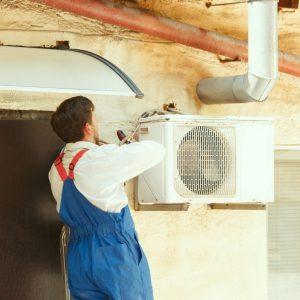Excess home humidity can cause a plethora of issues. Too much moisture can lead to discomfort, as the water molecules rest on the skin and impact how temperature is perceived. Additionally, it can lead to toxic mold growth, which is detrimental to one’s health and the value and integrity of a house.
The ideal home humidity level ranges from 30-40% in the winter and 50-60% in the summer. Here are some common signs that your house has excess humidity and what to do about it.
Signs of excess humidity
When it comes to identifying high humidity levels, some signs are more evident than others. You can often see the signs by looking at your windows. You might notice a bit of fog during the mornings or evenings as the temperature fluctuates, but there shouldn’t be moisture droplets running down the glass.
Other signs include a mildew smell or visible mold growth along with the windows and corners, particularly close to the ceiling. You might also notice that the temperature on the thermostat doesn’t match how the air feels. If you feel clammy or as though the air is sticking to you, it’s likely due to high humidity. Additionally, if you generally feel unwell more often or your allergies are hitting harder than usual, it could be a sign of excess moisture.
One way to test the humidity in your home is to use the ice water method. Fill a glass with water and a few ice cubes, then stir it around. Set the glass in a room other than the kitchen or bathroom and set a five-minute timer. If there are droplets on the outside of the glass (not just fog), your humidity levels are high.
Have your air conditioner serviced
When you’re concerned about humidity levels in your home, the first thing to do is contact an HVAC specialist. According to the experts at the highest-rated Cooling services Fort Worth, TX has to offer, excess humidity is a common sign that your air conditioner isn’t functioning correctly. In addition to cooling the air, your AC unit also aids with humidity control.
Having your air conditioner checked and serviced will hopefully correct the issue.
Check your attic insulation
The next step is to check your attic insulation. Attic insulation plays a vital role in keeping your home sealed and dry. If you can see the floor joists when looking straight in from the attic door, it’s time for another layer of insulation.
Check your bathroom ventilation
Many older homes have bathroom fans that vent directly into the attic. Sure, this removes moisture from your bathroom, but it delivers it right into the area meant to keep your home dry.
Check to determine whether your bathroom vents into the attic. If it does, consider cracking a window and turning down the heat while you shower until the issue is resolved. Your HVAC specialist can also provide guidance for the best course of action here.
Monitor for plumbing leaks
If everything seems to be in order, but you’re still experiencing excess humidity, it’s time to look for plumbing leaks. While excess condensation on pipes is another sign of too much moisture, leaks are a potential cause.
Look for visible signs of leaks by inspecting pipes and checking for targeted moisture along with the ceilings and walls. If a wall feels spongy or is slightly discolored, there may be a leaking pipe inside. Shut off the water and call a plumber immediately if you find an issue.
Use a supplementary dehumidifier
As you navigate the process of finding and correcting sources of excess humidity, it’s worth investing in a supplementary dehumidifier. You can get a small, portable unit from a department store or online to help protect your home and health until the issues are resolved.
Final words
If your home is showing signs of excess humidity, take these steps to resolve the issues as quickly as possible. Your health and resale value depend on it.




